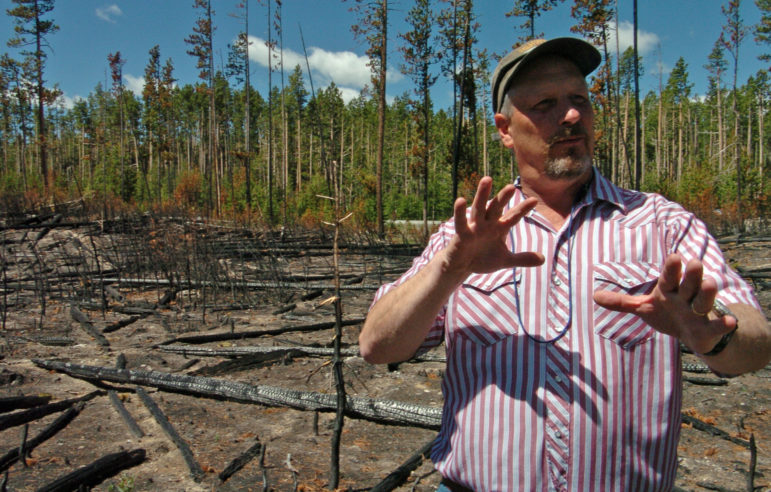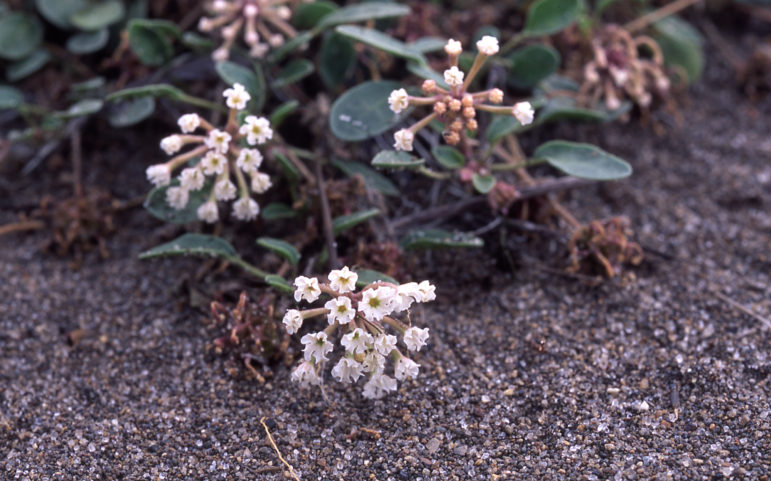
Roy Renkin, a vegetation specialist with the National Park Service, points out sections of a forest in Yellowstone National Park that were the subject of a prescribed burn in 2007 during a 2008 media tour looking back at the summer fires of 1988.
Gift shops in and around Yellowstone National Park are filled with postcards, videos and guidebooks featuring grizzly bears and gray wolves. But you’d be hard-pressed to find a photograph—or even a passing mention—of three much rarer species found only in Yellowstone.
Thanks in part to unique microclimates created by the park’s hot springs, fumaroles and other thermal features, Yellowstone is the only place on earth where you’ll find Ross’s bentgrass, Yellowstone sand verbena and Yellowstone sulfur wild buckwheat.
But most visitors to the park will never see these obscure plants.
Roy Renkin, Yellowstone’s vegetation management specialist, said that “plants are taken for granted here, mostly because they’re not as showy” as a baby bison, bugling elk or even a leaping trout.
“But they’re important,” Renkin said, describing not just the three species that grow only in relatively small sections of the park, but more widespread flora like whitebark pine.
According to Yellowstone Resources and Issues Handbook, Yellowstone is home to more than 1,300 species of vegetation—an amazingly diverse array of hardy plants that were able to repopulate the park after glaciers, lava flows and other cataclysmic changes.
That includes hundreds of different wildflowers, but also seven species of conifers and 218 non-native species.
“There’s a history why they’re here, and trying to understand them opens a wealth of information,” Renkin said of Yellowstone’s many plant species. “So it behooves us to pay attention.”
Unlike prowling animals, vegetation stays put, making rare plants easier to find and photograph. But most visitors aren’t interested in taking even a short hike to view, for instance, Yellowstone sand verbena.
Endemic to Yellowstone, the nondescript plant has sticky green leaves and small white flowers that rarely extend beyond three inches above the sandy soils where it is found.

Yellowstone sand verbana is found only along the shores of Yellowstone Lake.
Yellowstone sand verbena grows only on a 1.5-acre spot along the shore of Yellowstone Lake, not too far from a popular hiking trail, Renkin said. The plant thrives in warm soil, which may mean that it is aided by the park’s peculiar thermal environment.
Ross’s bentgrass, which grows just a few inches tall and flowers in early spring, is found only around geysers and thermal features in the Shoshone Geyser Basin and along the Firehole River drainage.
The plant grows only at “vapor dominated sites” like cracks in thermal areas or the walls of hot springs. Ross’s bentgrass requires just the right combination of warmth and moisture, conditions described by botanists as a “natural greenhouse.”
Yellowstone sulfur buckwheat grows only in the geyser basins along the west side of the park. Most of the more than 250 wild buckwheat varieties grow in dry areas of the Rocky Mountains. Taxonomists are still debating how different Yellowstone’s specific variety is from other wild sulfur buckwheats, Renkin said.
Renkin said none of Yellowstone’s vegetation is listed as a threatened or endangered species, but managers have the option to close trails or curtail human activities that might be detrimental to endemic plants.
In 2011, the U.S. Fish and Wildlife Service determined that protection under the Endangered Species Act was warranted for the whitebark pine, found above 7,000 feet across much of Yellowstone and in other areas across the Rocky Mountains. But the species was precluded from listing “by the need to address other listing actions of a higher priority,” the agency said.
Important as a food source for grizzly bears and in controlling erosion by slowing runoff from melting snow, whitebark pine faces threats from fire, climate change, the mountain pine beetle and white pine blister rust, a fungus that reduces the tree’s resistance to beetles.
Despite its importance across the region, more research is needed to determine how whitebark pine trees are established among rival lodgepole pines, particularly after wildland fires, Renkin said.
“There are some real information gaps relative to whitebark pine here in the Yellowstone ecosystem,” he said.
After decades working in Yellowstone, Renkin said he is always impressed with how the landscapes recovers after fires, changes in waterways and reclamation from past development.
“It’s really dramatic what happens when you let Mother Nature express herself,” Renkin said. “It’s amazing how resilient she can be.”
Contact Ruffin Prevost at 307-213-9818 or ruffin@yellowstonegate.com.
